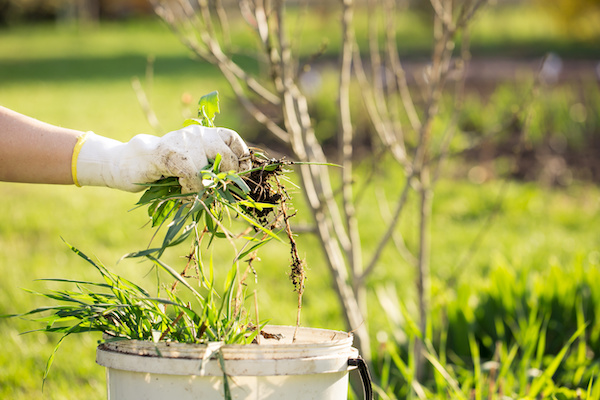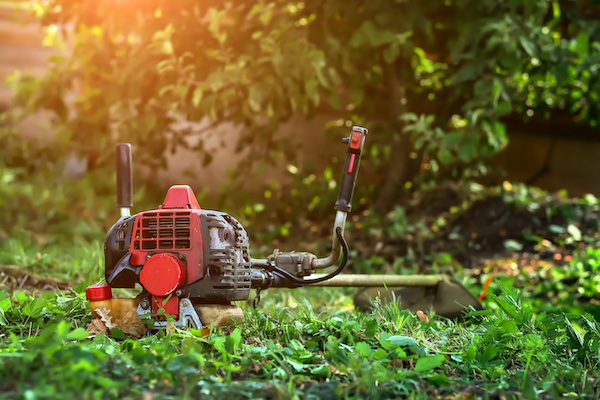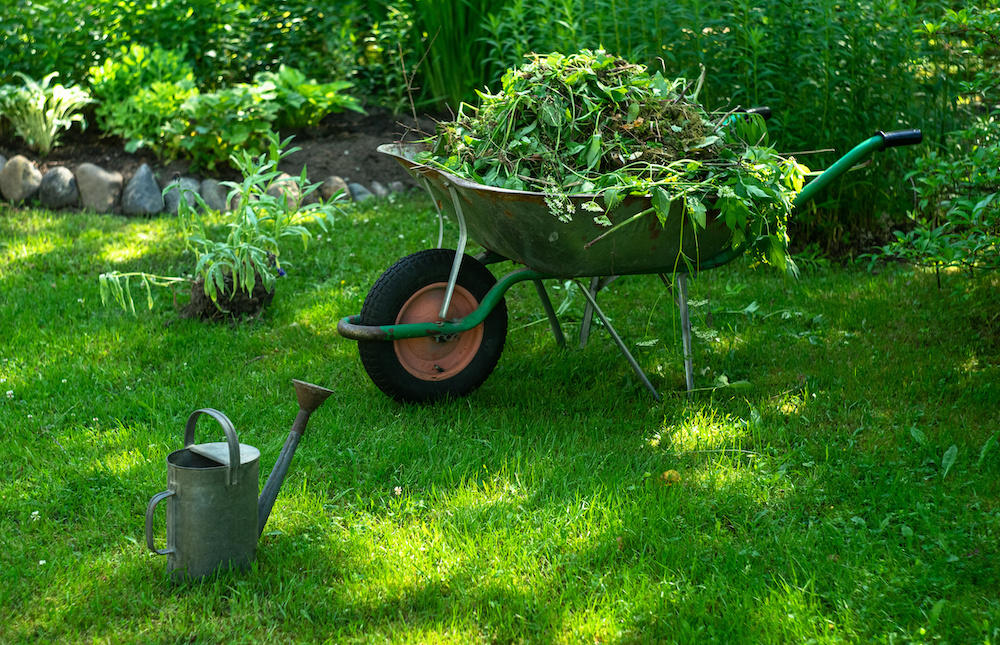Isn’t a lush, green lawn the dream for every homeowner? A well-maintained lawn not only adds curb appeal, but also provides a place for relaxation, play, and entertainment. However, achieving that perfect lawn requires knowledge, dedication, and the right techniques.
In this blog post, we’ll guide you through the process of creating and maintaining a beautiful lawn with our yard maintenance tips, while considering eco-friendly alternatives and pet-friendly options. These are tips you can implement yourself, or hire a yard maintenance company to do for you. Let’s dive in and discover the secrets to a vibrant, healthy lawn that will be the envy of the neighborhood!
Quick Summary of Our Yard Maintenance Tips
- Establish a healthy lawn through soil testing and preparation, selecting the right grass species and planting new seed.
- Mow once a week during growing season and remember to adjust the height to only cut the top 1/3 of the grass (cutting more can cause unnecessary stress to your grass).
- Water in the mornings between 6:00 AM and 10:00 AM about 2-3 times a week. The total amount of water should come to about 1-1.5 inches per week.
- The general rule of thumb is to fertilize every 6-8 weeks, but it can depend on the fertilizer you are using.
- Weeding can be reduced by applying weed killers and herbicides, but you will always need to pull the occasional weed or two (make sure to do this quickly before they mature and seed).
- Consider eco-friendly alternatives for sustainable maintenance and regularly service your equipment for optimal performance.
Table of Contents
Establishing a Healthy Lawn
The foundation of a beautiful lawn starts with establishing a healthy environment for grass to thrive. This involves testing and preparing the soil, selecting the right grass species, and planting new grass seed.
By taking the time to create a welcoming environment for grass to grow, you’ll be well on your way to achieving a lawn worthy of admiration.
Soil Test and Preparation
Understanding your soil composition is crucial to the success of your lawn. A simple soil test can reveal the pH and nutrient levels in your soil, allowing you to make the necessary amendments for a healthy lawn. You can purchase a soil testing kit from your local home improvement store or send a sample to a laboratory for analysis.
Once you have the results, it’s time to amend your soil. For instance, if your soil is too acidic, you may need to apply lime to raise the pH level. Adding organic matter, such as compost or aged manure, can also improve soil structure and provide essential nutrients for your grass.
Remember, a well-prepared soil is the foundation for a thriving lawn.
Selecting Grass Species
Choosing the right grass species for your lawn is critical to its success. Factors such as soil type, sunlight, and climate play a significant role in determining the appropriate grass species for your lawn. Cool season grasses, such as Kentucky bluegrass, grow well in cooler climates, while warm season grasses, like Bermuda grass, are better suited for warmer regions.
Consult with a lawn professional or your local home improvement store for customized recommendations for your specific lawn needs.
Planting New Grass Seed
After preparing the soil and selecting the right grass species, it’s time to plant new grass seed. Start by fertilizing the soil to provide essential nutrients for the growing grass.
Next, evenly spread the grass seed over the prepared soil, and cover the seeds with a thin layer of compost or straw matting to protect them and help retain moisture. Keep the seeded area well-watered until the new grass is established, and avoid walking on the area until the grass reaches a height of at least 3 inches.
Proper Lawn Care Techniques
A lush, green lawn requires ongoing care and attention. Proper lawn care techniques, such as mowing, watering, and fertilizing, will ensure that your grass remains healthy and vibrant throughout the growing season.
Implementing a regular lawn care routine will not only keep your lawn looking its best, but also help prevent weeds and other common lawn issues.

Mowing and Grass Clippings
Mowing your lawn regularly is crucial for maintaining its health and appearance. Aim to mow at least once a week during the growing season, and adjust the mower’s height to remove no more than one-third of the grass’s height at a time. This will help prevent stress on the grass and encourage healthy growth. Ensure that your mower’s blades are sharp, as dull blades can tear the grass and leave it vulnerable to disease and pests.
In addition to proper mowing techniques, leaving grass clippings on the lawn can serve as a natural fertilizer. As the clippings decompose, they release valuable nutrients back into the soil, promoting a healthier lawn. Consider using a mulching mower, which cuts grass clippings into smaller pieces, making it easier for them to break down and provide nutrients to the soil.
Watering
Watering is another essential aspect of proper lawn care. The best time to water your lawn is in the early morning, between 6 and 10 AM, when the temperature is cooler and less water is lost to evaporation. Aim to water deeply but infrequently, applying about 1 to 1.5 inches of water per week, divided into two or three sessions.
This will encourage deep root growth and help your lawn withstand drought and other stresses.
Fertilizing
Feeding your lawn with the right nutrients is vital for maintaining its health and appearance. Start by conducting a soil pH test to determine the specific nutrient needs of your lawn. Based on the results, choose a natural fertilizer that contains the appropriate nutrients and apply it using a spreader. Fertilize your lawn every 6-8 weeks during the growing season to ensure it receives the nutrients it needs to thrive.
When applying fertilizer, be cautious not to over-fertilize, as this can do more harm than good. Excess fertilizer can lead to rapid, weak growth, making your lawn more susceptible to pests, disease, and drought. By following the proper lawn care techniques, you’ll be well on your way to achieving a lush, green lawn that’s the envy of the neighborhood.

Weed Management
Taking the time and effort to properly manage weeds is often times the first yard maintenance tip we give homeowners who are struggling to improve their lawn. Weeds are a persistent problem that competes with your grass for nutrients, water, and sunlight. Effective weed management involves a combination of preventative measures, such as mulching and using pre-emergent herbicides, and active weed removal techniques, like hand-pulling and spot-treating with herbicides.
Preventative Measures
Preventing weeds before they become a problem is the best approach to maintaining a weed-free lawn. One effective preventative measure is mulching, which helps suppress weed growth by blocking sunlight and making it difficult for weed seeds to germinate.
Another option is to apply pre-emergent herbicides, which prevent weed seeds from germinating in the soil. By taking these preventative measures, you’ll be one step closer to a beautiful, weed-free lawn.

Weed Removal
Despite your best efforts, some weeds may still find their way into your lawn. In these cases, it’s important to remove weeds as soon as possible to prevent them from spreading. Hand-pulling weeds is an effective method, especially for small infestations. Be sure to pull the entire weed, including the roots, to prevent regrowth.
For larger weed problems or stubborn perennial weeds, a targeted herbicide application may be necessary. Always follow the label instructions and use caution when applying herbicides to minimize the risk of damage to your lawn and the environment.
Lawn Aeration and Overseeding
Lawn aeration and overseeding are important techniques to improve soil quality, promote root growth, and maintain a lush lawn. Aeration involves creating small holes in the soil to allow air, water, and nutrients to reach the grass roots, while overseeding helps to fill in patchy areas and improve the overall appearance of your lawn.
By incorporating these techniques into your lawn care routine, you can ensure a healthy, vibrant lawn throughout the year.
When to Aerate
The ideal time to aerate your lawn depends on the type of grass and climate in your area. For cool-season grasses, such as Kentucky bluegrass, the best time to aerate is during the early spring or early fall, when soil temperatures are in the 50-65 degree range.
For warm-season grasses, such as Bermuda grass, it’s best to aerate in mid to late spring. Proper timing is crucial to ensure that your lawn benefits from the aeration process and can recover quickly.

Choosing a Lawn Aerator
Selecting the right lawn aerator for your specific lawn needs is essential for effective aeration. There are two primary types of lawn aerators: plug aerators and spike aerators. Plug aerators remove small plugs of soil and are more suitable for highly compacted lawns, while spike aerators simply create holes in the soil and are better for naturally looser soil.
Consider factors such as the size of your lawn, the type of soil, and the level of compaction when choosing a lawn aerator to ensure optimal results.
Overseeding
Overseeding is the process of sowing grass seed into an existing lawn to improve its density and fill in any bare spots. To oversee your lawn, first mow the grass at a low height and rake to remove any debris. Then spread the grass seed evenly over the lawn using a spreader or by hand.
Water the seeded area regularly, keeping it moist until the new grass is established. Be patient, as it may take several weeks for the new grass to become established and blend with the existing lawn.
Pest Control and Pet Considerations
Pest control and pet considerations are important aspects of lawn care. Managing lawn pests with natural methods not only protects your lawn, but also keeps your pets and the environment safe.
Creating a pet-friendly yard ensures that your furry friends can enjoy the outdoor space without causing damage to your lawn or exposing themselves to harmful chemicals.
Managing Lawn Pests
Managing lawn pests effectively while keeping your pets safe can be achieved with a combination of natural methods and pet-safe products. Diatomaceous earth, for example, is a natural substance that can be used to control a variety of pests without harming your pets.
Additionally, planting mosquito-repelling plants such as lemon eucalyptus and pine can help keep your yard comfortable and pest-free. Always prioritize the safety of your pets and the environment when choosing pest control methods for your lawn.
Pet-Friendly Yards
Creating a pet-friendly yard involves providing a safe and comfortable environment for pets to enjoy. This includes selecting dog-safe ground covers, such as buffalo grass or clover, and ensuring that your yard is free from toxic plants and chemicals.
Additionally, secure fencing and outdoor lighting can help keep your pets safe and visible while they explore the yard. With a little planning and consideration, you can create a yard that both you and your pets can enjoy.
Seasonal Yard Care
A well-maintained lawn requires attention throughout the year, with different tasks and considerations depending on the season. Seasonal yard care involves spring maintenance to rejuvenate the lawn after winter, summer maintenance to keep the lawn healthy during the hottest months, and fall maintenance to prepare the lawn for winter dormancy.
By following a seasonal lawn care routine, you can maintain a beautiful, healthy lawn all year round.
Spring Maintenance
Spring is the ideal time to give your lawn a fresh start after the winter months. Start by raking your lawn gently to remove any dead grass, leaves, and debris that may have accumulated over the winter. Aerate your lawn to allow air, water, and nutrients to reach the grass roots, and oversee any thin or patchy areas to improve the overall appearance of your lawn.
Additionally, dethatch your lawn to remove any buildup of dead grass and debris, which can inhibit proper air circulation and promote disease. Apply pre-emergent herbicides to prevent weed seeds from germinating, and fertilize your lawn to provide essential nutrients for the growing season.
Finally, begin watering your lawn regularly to encourage new growth and establish a strong root system.
Summer Maintenance
During the hot summer months, proper lawn care is essential for maintaining a healthy, green lawn. Mow your lawn regularly, adjusting the mower’s height to maintain a grass height of 2-3 inches. This will help prevent stress on the grass and encourage healthy growth.
Water your lawn deeply but infrequently, applying about 1 to 1.5 inches of water per week, divided into two or three sessions. Fertilize your lawn every 6-8 weeks during the growing season to ensure it receives the nutrients it needs to thrive.
Fall Maintenance
Fall is the perfect time to prepare your lawn for the winter months ahead. Begin by raking your lawn to remove leaves and debris, allowing sunlight to reach the grass and prevent the formation of snow mold. Aerate your lawn to improve the soil’s ability to absorb water and nutrients, and oversee any thin or bare areas to improve the overall appearance of your lawn.
Dethatch your lawn to remove any buildup of dead grass and debris, and fertilize your lawn to provide essential nutrients for the winter months. By following these fall maintenance steps, you’ll help ensure a healthy, beautiful lawn come springtime.

Eco-Friendly Lawn Alternatives
In addition to traditional lawn care, there are eco-friendly lawn alternatives that can provide a low-maintenance, environmentally friendly option for your yard. Ground covers, native plants, and artificial turf can reduce water usage, eliminate the need for harmful chemicals, and provide a beautiful, sustainable alternative to a traditional grass lawn.
Consider incorporating these eco-friendly options into your yard to save time, resources, and promote a healthier environment.

Lawn Equipment Maintenance
Proper maintenance of your lawn equipment is essential for optimal performance and a beautiful, well-kept lawn. Regularly sharpen the blades of your mower to ensure clean, even cuts, and clean the undercarriage after each use to prevent buildup of grass clippings and debris.
Schedule a yearly tune-up with a professional to keep your equipment running smoothly and efficiently, as well as to address any potential issues before they become major problems. By investing time and effort into maintaining your lawn equipment, you’ll be well-equipped to handle the various tasks required for a lush, healthy lawn.
Going Beyond Yard Maintenance Tips
Maintaining a beautiful yard requires dedication, and knowledge of proper techniques. By following the steps outlined in this blog post, you’ll be well on your way to improving your lawn and possibly making it the envy of the neighborhood.
One thing we didn’t cover much in this post is the true time commitment yard maintenance takes. From regular mowing, weeding, fertilizing, and all the other miscellaneous tasks, it can end up taking quite a bit of time (most of which will be on the weekends). This is where professional lawn care companies like Three Timbers can help. Not only will we guarantee your yard looks great, but we will save your precious time that you can now spend with your family.
If you happen to be located in Minnesota or Arizona, our team at Three Timbers would love to help you achieve the yard of your dreams. Contact us today to learn more!


